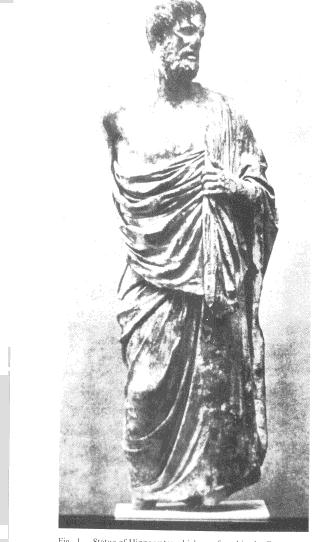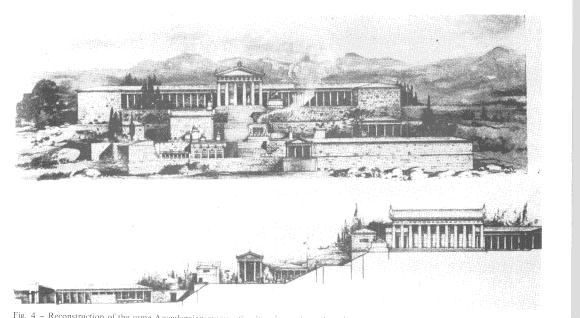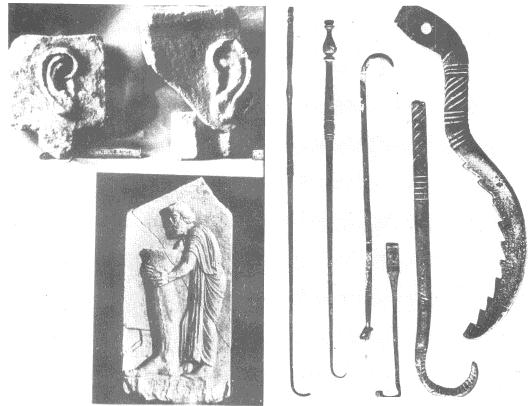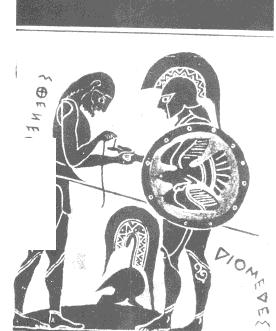Annals of the M.B.C. - vol. 1° - n° 1 -
September 1987
CONCLUSIONS ON HIPPOCRATIC BEHAVIOUR IN
THE TREATMENT OF WOUNDS AND BURNS
Polycratis G.S.
Athens University
SUMMARY. The intention of this
paper is not to solve positively today problems of wounds and bums, but to point out that
Hippocrates, 2500 years ago, faced sufficiently similar problems by placing medicine on a
strictly scientific level. In the large collections of his many writings, which amount to
100, many are interesting, describing methods of curing diseases. His knowledge of surgery
of the head is reported in detail, and an operation in the lower eyelids is depicted
distinctly. Regarding bums, by close observation of their surface appearance, he could
estimate their condition. His efrorts in local treatment aimed to keep them clean and dry,
in some cases by applying soft and soothing emollients and in more serious cases, more
drastic substances; these methods proved to be helpful.
His ideas in medicine and surgery were followed for many years and constituted the
anticipation of modem knowledge. Hippocrates because of his important contribution has
justifiably been recognised as the legislator and the father of medicine.
Opening Lecture
Mr. President, dear Colleagues,
Before 1 start this opening lecture, 1 think 1 must to address congratulations to the
contributors to the foundation of the Mediterranean Bums Club, and especially to Professor
S.W.A. Gunn, acting President of the M.B.C., as well as to Professor Michele Maselliswho
considerably contributed as the President of the Organizing Committee of this Meeting to
its exceptional and admirable success.
On the occasion of this Inaugural
Ist Meeting, 1 am offering now to the Presidency a remembrance of my country. This is a
Greek relief of the 4th Century B.C. which represents the God of Medicine, Aesculapins,
holding his characteristic stick, with the snake rolled up around it (symbol of Medicine)
and a patient nearby asking for medical help.
Introduction
The intention of this paper is not to
solve positively current problems in the treatment of wounds and bums, but to point out
how, 2500 years ago, a man Hippocrates, without today's technological equipment, faced
sufficiently similar problems. In addition he was the first who placed medicine on a
strictly scientific level, based on objective observation and critical deductive
reasoning, separating thus medicine from superstition, from philosophical speculation as
well as from religious influences.
History
Hippocrates Figil, whose father was a
physician, was born in the island of Cos in 460 B.C. and died in Thessaly at about the age
of 90. He lived in the Golden Age of Pericles - the contemporary of Herodotus, Socrates,
Sophocles and Democritus. He founded the Coan School, where he taught for many years.
Although he followed the current belief that diseases result from an imbalance of the 4
body humors (blood, phlegm,'yellow and black bile), he maintained that the disturbance was
influenced by outside forces and that the humors are glandular secretions. He believed
that the goal of medicine should be to build the patient's strength through appropriate
diet, and hygienic measures, resorting to more drastic treatment only when the symptoms
showed this to be necessary. Hippocrates noted not only many of the signs of the diseases,
by proper observation and by close bodily examination,. but also that similar symptoms
appear through a family, or a community, or even in successive generations. In the large
collections of his writings and texts, which amount to one 100, many are important, among
them: "The waters, airs, and places". He states that these 3 factors have
considerable influence in the cause of diseases. Therefore if one knows the quality of
these 3 factors, under which the patient is living, one cannot miss the interesting
conditions which contribute to the creation of the illness. And only after taking into
consideration these factors must one proceed very attentively to the patient, for local
examination. These ideas are an anticipation of modem knowledge.
Hippocrates was aware of many
contemporary illnesses and epidemics; an important contribution was when he drove out the
plague of Athens, by lighting fires in the public squares. The basic principles of the
cure of diseases were the following: proper diet, particular to each illness, fresh air,
medical waters, and when the case permitted it gymnastics; finally surgical procedures if
needed. Fig. 2, Fig. 3, Fig. 4.
 |
Fig. 1 - Statue
of Hippocrates which was found in the Conservatory of the island of Cos. |
|
Surgery and wounds
Surgery was in a more advanced situation. In the chapter of operative surgery, the
following factors related to an operation are taken into consideration: the patient, the
operator, the assistants, the instruments, the lights of the operating place (there are
two forms of light, the natural and the artificial). Also the time of the operation, the
manner of it, and others.
In addition, the posture of the
operator, whether he is sitting or standing, his distance from the patient, the accurate
placing of his hands, and so forth.
When he had to close a wound by
sutures, he paid attention to some details in the way he had to pass the suture, as well
as the place of the knot. And he says: when we pass a thread through the sides of a wound,
in order to close is as best as possible, the knot should not be in a downward direction
into the wound, but in an upward direction, out of the wound.
When ligatures have be placed,
the knot should be in the wound, and not be exposed to friction. The thread should be soft
and not dry, and the ends of the knot should not be large.
Recent open wounds, not inflamed,
were cleaned attentively, with clean hands, and rinsed or washed with clean water after
boiling it, and mixed with white wine, and then should be closed and dressed. The dressing
of a wound contributes to the cure of the wound. The force of the constriction should be
such as to prevent the adjoining parts from separating, without compressing the muche, so
that the parts may be adjusted, but not forced together. And also the constriction should
be small at the extremeties and least of all in the middle. For all these purposes
Hippocrates used many many forms of bandages. For example: the simple, the slightly
winding, the sloping, the monoculous, the rhombus, the semi-rhombus and many others.
Bandages must be applied without pain to the patient, with elegance, to fit well, to be
neat and soft and followed closely, and released when pains or oedema appear.
Wounds complicated with
inflammation or suppuration are treated after cleaning them with water and wine by
application of warmed cataplasms. These were a kind of poultice, composed by special and
very rare plants, leaves, flowers, bark of trees, etc. Some cataplasms were composed
barley flour, in the form. of paste after being well warmed. Incisions were made when the
wodnds were infected or swollen. In cases of very dirty wounds, in order to remove the
putrid parts of the wound, he would use corrosive powder.
Different kind of chronic ulcers,
mostly of the lower legs, were treated either with conservative or by surgical way.
Fig. 5.
Injuries and wounds of the
head
Hippocrates in this chapter describes
in detail anatomical elements of the skull and face as well as their bones, their sutures,
their meninges etc. From the uppermost to the lowermost parts, the bone of the skull
gradually becomes softer, till it comes to the diploe. This is the most porous and
cavernous part, with slender and hollow vessels full of blood.
 |
Fig. 3 - Another
view of the Aesculepeion with its 3 levels (social events, statue places, temple and
medical school). |
|
 |
Fig.
4 - Reconstruction of the same Aesculepeion representing it as it was in ancient
times. |
|
The thinnest and weakest part is around the bregma with
the thinnest flesh upon it. But hence it happens that a wound upon this place is more
serious, and more easily contused, fractured and depressed.
The examination of a wound of the head
and face, begins with determination of the part where the wound is situated, as well as
its extent and its depth. When hairs of the scalp have gone into the wound, this is a sign
that the wounds is deep.
Simple wounds of the head and face
should be closed. Old extensive or lacerated wounds, or inflamed ones, must be treated as
follows: first they should be cleaned and then cered with pitch, having been heated, is to
be applied to the wound, and then bound by thin folded compresses, and the parts around
are to be anointed with white cerate.
When the wound has not sufficient length
and breadth, for a better inspection of the underlying tiSsues and bones, incisions may be
practised. Deep incisions of the bregma of the skull should be avoided, because
convulsions seize, and if the incision is in the left side, convulsions seize in the right
side, and viceversa.
If inflammation or suppuration takes
place, and by hot cataplasms the swelling subsides, and if pieces of flesh in the wound
become dead, they will separate and fall off. With this plan of treatment, the sore will
come more quiely to cicatrisation and healing. Fig. 6.
In cases of fracture of the skull,
simple or depressed, he speaks of trephination with the trephine, a crown saw for removal
of a circular disk, approximately the same as it is used today by neursurgeons. In cases
of fractures of the jaws, after their reduction, they are restrained by the adjoning
teeth, as we do today. For lichen of the mouth commissure, or for skin eruptions, he
performed cauterization with the blue stone of copper, as was used some years ago.
And now 1 am going to describe an
interesting operation which Hippocratis performed in the lower eyelids, when eyelashes,
were growing inwards. Namely the operation of Trichiasis, performed as follows: Having
introduced a thread into the eye of a needle, as we do today, push it through the skin of
the upper part of the lower eyelid (close to the eyelashes) and do the same at the base of
it, with the same thread. Having stretched the ends of the thread, tie a knot in them and
bind up, until eyelashes drop outwards. And if this is sufficient, so far so good. But
otherwise, you must do the same thing with another similar thread, in the place where it
is still needed. And thus the outwards direction of the eyelashes of the lower eyelid will
be completed.
 |
Fig. 5 -
Dedications of suffering members (cars and lower leg withvaricous veins, which by pressure
become more obvious). |
|
Generally we can say
that Hippocrates, surgical knowledge, from the general point of view, was not negligible.
Also many methods of hemostasis are reported, for example: by pressure of the surface of
the wound, by application of styptic substances, by cauterization of the bleeding vessels,
by ligation, and others. Fig. 7.
Aphorisms
Before 1 discuss the chapter of the burns, 1 would like to say a few things about
an interesting chapter, the Aphorism. The Hippocratic Aphorisms are proverbs and maxims
related to diagnosis, prognosis, and treatment of illnesses, as well as to philosophical
ideas. They amount to more than 400, but 1 am going to mention only 10, the most
representative:
- Life is short, art is long, crisis is fleeting, experience perilous, and decision
difficult.
- Extreme diseases need extreme methods of cure.
- All diseases occur at all seasons of the year, but certain are more apt to occur and to
exacerbate at a certain season.
- Persons who are accustomed to endure habitual labors, although they be weak or old, bear
them better, than strong and young persons, not accustomed to it.
- Persons who are naturally very fat are apt to die earlier than those who are slender.
- Muscles being more solid waste less easily than other parts of the body.
- Things having a similar substance can easily change into one another, while it is
impossible for those which are very different.
- South winds induce dullness of hearing, dimness of vision, heaviness of the head, torpor
and langour.
- Blood or pus in the urine indicate ulceration
either of the kidneys or of the bladder.
- Parts that have been exercised resist change, being stronger and therefore less liable
to waste.
 |
Fig. 7 -
Sthenelos bandaging the hand of Diomedes, a hero of Troyan war, who is regarded
as the founder of cities in Sout-hern the Italy, where he immigrated. |
|
And finally a general aphorism for the complete education of a surgeon he
who wants to be a skillful surgeon, must have sufficient experience of military surgery,
namely, war surgery. Therefore he has to be drafted in foreign mercenary armies, and
follow them in the field of battle, in order to operate on war wounds, to remove missiles
amd foreign bodies, and only thus may he have a full surgical education and a complete
technical dexterity.
Burns
As you know, fire, as
the result of combustion and flames, is the main cause of burns. Fire in ancient Greece
and later on was considered one of the 4 basic elements, a substance from which all things
are composed (i.e. fire, air, water and earth). The great importance of fire to man has
made fire divine or sacred to many people. The most carefully preserved cult in Rome, was
that of Vesta, goddess of the Hearth and her virgins guarded the Holy Fire.
Prometheus stole fire from
Olympus and brought it to mankind. (May be to torture and puzzle plastic surgeons ... )
Before Hippocrates, the earliest account of the treatment of bums is recorded as you know
in the Papyrus of Ebers, 1500 years B.C. At that time "a frog was warmed in oil and
rubbed on the burned surface". This was the main treatment, repeated for 5
consecutive days. It is self-evident that by this method the burns usually suppurated.
Later on, in the medicine of
ancient Egypt, local physical signs were used in the treatment of burns, to gauge their
progress and to be a guide to the remedies applied. And also in this way suppuration was
regarded as an unavoidable complication.
Hippocrates by observation of the
surface appearance as well as of the extent of the lesions, unlike those methods
described, taught the great principle of avoiding as much as possible local irritation.
Instead of rubbing the surface with different elements, he proposed the method of simple
and mild cleanliness of the burned surface. So he washed it attentively and mildly with
clean water, after being boiled, and then moderately cooled, until hands could bear its
temperature. In some cases he mixed the water with some white wine. After this procedure
an attempt was made to keep by all means the burned surface dry and clean. In mild cases
he does not refer to covering with dressings.
In advanced cases he advised an
empirical treatment, the following: having melted old hog lard and mixed it with resin and
bitumen, and having spread it on a piece of cloth, he warmed it. After cooling it, he
applied it on the burned surface and he covered it by proper dressings. This method was
preferable for advanced cases over others which were complicated, with more remedies as
they are described in detail in his writings. But this one which 1 have mentioned, with
old hog lard, resin, and bitumen, was proved the most effective, the simplest, and wihout
any corrosive activity. It acted as an emollient with softening and soothing effects.
After all these investigations of
Hippocrates many writings about burns treatment, my conclusions are the following:
Hippocrates in the treatment of bums in serious and advanced cases used very drastic
substances, and only those were covered, as he reports, with proper dressings. Therefore,
superficial and mild burns were treated by exposure uncovered and the progress of healing
was obtained by keeping them by all means dry and clean.
In the years following years
Hippocrates there was no development in the understanding of the treatment of bums. In
fact the whole rationale was distorted and fixed by two superstitions. The first was that
suppuration was essential and helpful to healing. In other words a retrograde doctrine for
which Galen was responsible took place. The second superstition was a pre-Hippocratic
Aphorism that "diseases not curable by iron are curable by fire- which had influenced
the Arabian School of Avicenna which "used the cautery instead of the Knife".
Unfortunately these faulty ideas
in the treatment of bums were held for a long period of time even up to the 12th century,
in spite of many efforts to return to Hippocratic principles for the treatment of burns,
Still today there are surgeons who for diagnosis of the degree of bums regard like
Hippocratis the surface appearance in combination with the sensitivity of a pin-prick,
instead of more complicated and less imreliable methods.
Dear Colleagues, finishing my short historical lecture, 1 have tried to underline in a
broad manner basic principles of Hippocrates related to surgery and to our specialty, a
lot of them in progress in medicine 2500 years ago.
Reading his writings, especially
in the original, one will admire the didactic doctrine by which he analyses with care
every subject of his colossal work, and his extensive literal contribution. Hippocrates in
addition was the ideal physisian who with purity and holiness lived his life and practised
the art of medicine. And by his famous oath, he expressed what a physician should aspire
with morality to be in relation to the patient and to society. Thus justifiably he has
been recognized as the legislator and the father of medicine.
RÉSUMÉ. Ce résumé n'a pas l'intention de
résoudre positivement aujourd'hui les problèmes concernant les blessures et les
brûlures, mais de préciser que Hippocrate, il y a 2500 ans, avait affronté suffisamment
les mêmes problèmes en mettant la médecine sur un plan strictement scientifique.
Dans la vaste collection de ses nombreux écrits, une centaine, il décrit des méthodes
fort intéressantes pour soigner les maladies. Ses connaissances sur la chirurgie de la
tête sont rapportées avec soin et une opération des paupières inférieures est
décrite avec détails. Concernant les brûlures, en observant bien attentivement leur
superificie, il pouvait faire une estimation de leur condition. Ses effects sur le
traitement local tendaient à les tenir au propre et au sec, en certains cas à y
appliquer des émulsions douces et calmantes, et quand elles sont plus sérieuses, des
substances plus radicales; il est prouvé que ces méthodes sont utiles.
Ses idées concernant la médicine et la chirurgie, suivies pendant des années,
anticipèrent la science moderne.
Hippocrate grâce à son importante contribution a été reconnu à juste titre le
législateur et le père de la médecine.
|




